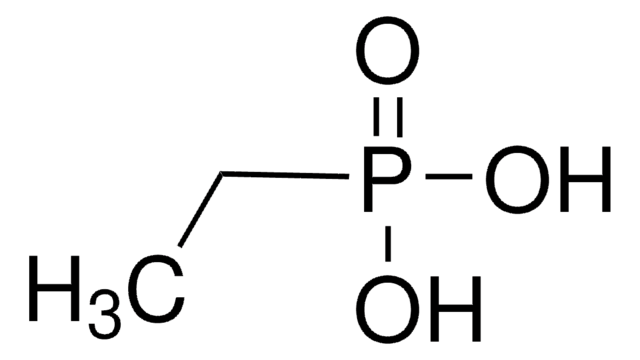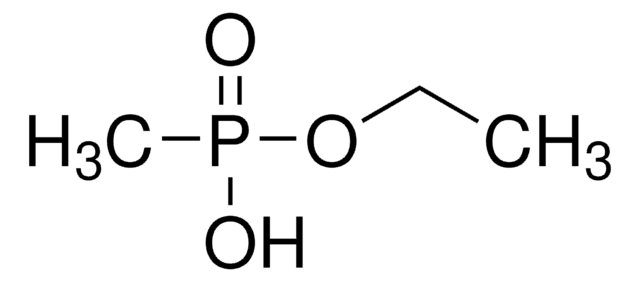All Photos(1)
About This Item
Linear Formula:
CH3(CH2)5P(O)Cl2
CAS Number:
Molecular Weight:
203.05
MDL number:
UNSPSC Code:
12352100
PubChem Substance ID:
NACRES:
NA.22
Recommended Products
Assay
95%
form
liquid
refractive index
n20/D 1.465 (lit.)
bp
114-121 °C/16 mmHg (lit.)
density
1.185 g/mL at 25 °C (lit.)
functional group
phosphine oxide
SMILES string
CCCCCCP(Cl)(Cl)=O
InChI
1S/C6H13Cl2OP/c1-2-3-4-5-6-10(7,8)9/h2-6H2,1H3
InChI key
GZXBQDURAKBNAZ-UHFFFAOYSA-N
Related Categories
Application
Hexylphosphonic dichloride was used in preparation of:
- hexylphosphonic acid via reaction with water
- phosphonate esters
- methyl 4-methylumbelliferyl hexylphosphonate
Signal Word
Danger
Hazard Statements
Precautionary Statements
Hazard Classifications
Acute Tox. 4 Oral - Eye Dam. 1 - Skin Corr. 1B
Storage Class Code
8A - Combustible corrosive hazardous materials
WGK
WGK 3
Flash Point(F)
235.4 °F - closed cup
Flash Point(C)
113 °C - closed cup
Personal Protective Equipment
dust mask type N95 (US), Eyeshields, Gloves
Choose from one of the most recent versions:
Already Own This Product?
Find documentation for the products that you have recently purchased in the Document Library.
Active-site titration analysis of surface influences on immobilized< i> Candida antarctica</i> lipase B activity.
Laszlo JA, et al.
Journal of Molecular Catalysis. B, Enzymatic, 69(1), 60-65 (2011)
Mechanisms of the shape evolution of CdSe nanocrystals.
Peng ZA and Peng X.
Journal of the American Chemical Society, 123(7), 1389-1395 (2001)
Alessandra Mezzetti et al.
Chemistry & biology, 12(4), 427-437 (2005-04-27)
Synthetic chemists often exploit the high enantioselectivity of lipases to prepare pure enantiomers of primary alcohols, but the molecular basis for this enantioselectivity is unknown. The crystal structures of two phosphonate transition-state analogs bound to Burkholderia cepacia lipase reveal this
Our team of scientists has experience in all areas of research including Life Science, Material Science, Chemical Synthesis, Chromatography, Analytical and many others.
Contact Technical Service









